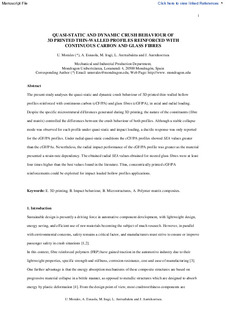Izenburua
Quasi-static and dynamic crush behaviour of 3D printed thin-walled profiles reinforced with continuous carbon and glass fibresBertsioa
Berrikusten dagoen preprinta
Eskubideak
© 2021 Elsevier LtdSarbidea
Sarbide irekiaArgitaratzailearen bertsioa
https://doi.org/10.1016/j.compositesb.2021.108865Non argitaratua
Composites Part B: Engineering Vol. 221. N. artículo 108865Argitaratzailea
ElsevierGako-hitzak
polymer-matrix compositesImpact behaviour
Microstructures
3D printing
Laburpena
The present paper investigates the suitability of cFF printed material and technologies for crashworthiness applications. To this end, the quasi-static and dynamic crush behaviour of 3D printed thin-w ... [+]
The present paper investigates the suitability of cFF printed material and technologies for crashworthiness applications. To this end, the quasi-static and dynamic crush behaviour of 3D printed thin-walled hollow profiles reinforced with continuous carbon (cCF/PA) and glass fibres (cGF/PA), in axial and radial loading were analysed. Despite the specific microstrutural differences generated during 3D printing, the nature of the constituents (fibre and matrix) controlled the differences between the crush behaviour of both profiles. Although a stable collapse mode was observed for each profile under quasi-static and impact loading, a ductile response was only reported for the cGF/PA profiles. Under radial quasi-static conditions the cCF/PA profiles showed SEA values greater than the cGF/PAs. Nevertheless, the radial impact performance of the cGF/PA profile was greater as the material presented a strain-rate dependency. The radial SEA values obtained for steered glass fibres were lower than those values obtained for axial loading. However these SEA values are promising, in that they were at least 2–3 times higher than any values found in the literature. The results therefore indicate that concentrically printed cGF/PA reinforcements could be exploited for impact loaded hollow profile applications. [-]





















